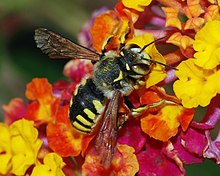| Anthidium Temporal range:
| |
|---|---|

| |
| Anthidium florentinum | |
| Scientific classification | |
| Domain: | Eukaryota |
| Kingdom: | Animalia |
| Phylum: | Arthropoda |
| Class: | Insecta |
| Order: | Hymenoptera |
| Family: | Megachilidae |
| Tribe: | Anthidiini |
| Genus: | Anthidium Fabricius, 1805 |
| Type species | |
| Apis manicata[1] | |
Anthidium is a genus of bees often called carder or potter bees, who use conifer resin, plant hairs, mud, or a mix of them to build nests. They are in the family Megachilidae which is cosmopolitan in distribution and made up of species that are mostly solitary bees with pollen-carrying scopa that are only located on the ventral surface of the abdomen. Other bee families have the pollen-carrying structures on the hind legs. Typically species of Anthidium feed their brood on pollen and nectar from plants. Anthidium florentinum is distinguished from most of its relatives by yellow or brick-red thoracic bands. They fly all summer and make the nests in holes in the ground, walls or trees, with hairs plucked from plants.
Most Anthidium species are leaf-cutting bees who use conifer resin, plant hairs, earth, or a combination of these as material for the nest walls. Their abdominal bands are usually interrupted in the middle. There is no lobe (arolium) between their claws. Anthidium manicatum is commonly known as the wool carder bee which uses comblike mandibles to "comb" plant fibers into its brood cell walls. It has spread from Europe to North and South America. The males are much larger (ca. 18 mm) than the females (ca.12 mm) which is not uncommon among Megachilidae, but very rare among other bee families (e.g., the true honey bees, genus Apis). The males also have three "thorns" at their abdominal apex which they use as weapons when defending their territory.